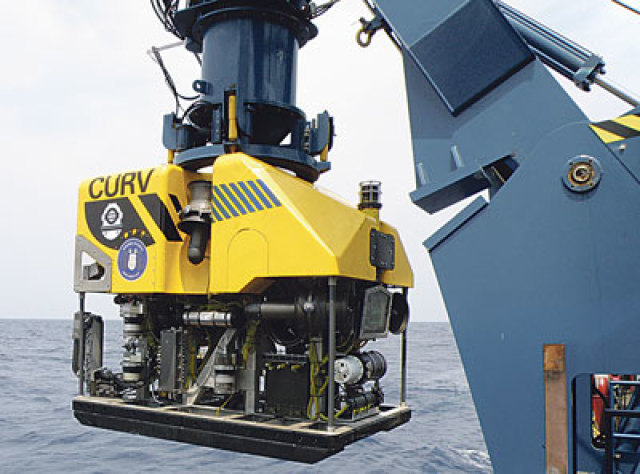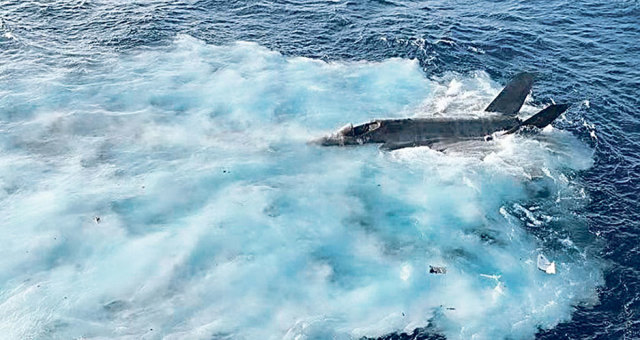Will the Americans get the remains of the Ross "Zircons" from the bottom of the Barents Sea?
The Americans, having lifted the wreckage of the F-35C fighter from the depths of the South China Sea, proved that they are able to find and raise even small objects to the surface if the search area is narrowed. Therefore, it is possible that they will be able to raise the remnants of Russian missiles from the bottom of the Barents Sea and learn the secrets of the latest samples of our weapons from the finds.
Recall that when on March 3, 2022, the Pentagon announced the lifting of the F-35C Lightning II multipurpose aircraft from the bottom of the South China Sea, many on the Potomac breathed a sigh of relief. The newest American combat aircraft crashed while landing on the deck of the aircraft carrier Carl Vinson and suddenly found itself at the bottom of the neutral waters of the South China Sea. At the same time, we note that almost all of this water area in China is considered their own and the Chinese theoretically had the opportunity to directly search for the crashed aircraft.
So a kind of race began when lifting the wreckage, the results of which the Americans could use only for possible litigation, and the Chinese could be given information about the latest aviation and electronic technologies stuffed with the most modern aircraft equipment. On board the lost F-35C there were not only instruments, but also classified communication and data transmission devices, a combat identification system with encryption devices – in fact, a flying supercomputer drowned, and it would be very tempting for the Chinese to get acquainted with the latest technologies.
The Americans were in no hurry to lift the wreckage of the F-35. The accident occurred on January 24, 2022, and the special research deep-sea search vessel DSCV Picasso did not leave Okinawa for the sea until February 23, 2022. It was a high risk, as the plane crashed in neutral waters about 300 kilometers to the west. The Chinese also roughly knew the location of the wreckage – it's no secret that the Chinese Navy is constantly monitoring the position of American ships.
“The drowned American LA was discovered after just a few days of exploration. This means that the technologies of searching and working at great depths are becoming more and more perfect.”
The authorities in Beijing were aware of the potential area of operation of the American aircraft carrier, especially since after the accident there is always confusion in the directions of movement of the aircraft carrier team and even in the methods of radio communication. The impact of the aircraft on the deck led to a fire, seven wounded (three had to be taken to a hospital in Manila in the Philippines) and the need to redirect the aircraft to board the second aircraft carrier operating in this region, the USS Abraham Lincoln. The sunken plane was at a depth of 3779 meters.
As a result, the Americans won the race by using a civilian vessel specializing in underwater work. Specialists of the US Navy, mainly from the rescue and diving inspection SUPSALV (Supervisor of Salvage and Diving), who carried out search work and ensured the safety of the sunken aircraft, boarded the DSCV "Picasso".
In the end, the drowned American LA was discovered after just a few days of exploration, which means that the technology of searching and working at great depths is becoming more and more perfect. Recently, this is the second successful operation of this kind. In December 2021, the wreckage of the F-35B Lightning II, lost by the British Navy in the Mediterranean Sea, was discovered. At the same time, the plane was searched for, fearing not Chinese, but Russian search and research vessels.
In the case of the South China Sea, an ROV (remotely operated vehicle) with a cable-controlled underwater robot CURV-21 (Cable-controlled Undersea Recovery Vehicle) was used for work at a depth of more than three thousand meters. It is capable of operating at depths of up to six thousand meters. It requires a powerful descent and ascent system, since it weighs 2,900 kilograms and has relatively large dimensions (2.44 meters long, 1.52 meters wide and 2.13 meters high). However, such a system does not have to be specialized, which means that the CURV-21 can be installed on almost any vessel equipped with a crane of the appropriate lifting capacity and with a suitable working deck.
CURV-21 can be controlled in all six directions of movement under water and has automatic control of depth, height and course. The robot is equipped with CTFM sonar (with continuous frequency modulation of transmission) to monitor the bottom with a range of 600 meters, an acoustic transponder detection system (so-called pingers), a high-resolution digital camera, a black-and-white camera and a color television camera. The image from the sensors is transmitted to the surface in real time via a fiber-optic cable.

Photo: google.com
For underwater work, a special articulated manipulator with a multifunctional grip is used. It was with his help that specialized hoists and ropes were attached to the wreckage of the aircraft, which were then connected to a crane on the cargo deck of the Picasso. Now the emergency F-35C will be delivered to the United States, where it will be examined in order to establish the cause and consequences of the flight accident that occurred.
Hence the question arises: will the Americans be able to get the wreckage of Russian "Zircons" from the depths? The detection and lifting of both F-35s proves that the shtatovtsy can find any object under water if they approximately know its location. This applies not only to NATO's weapons systems, but also to Russian and Chinese ones. Theoretically, maritime law does not prohibit this, unless underwater exploration is conducted exclusively in the maritime economic zone of another country.
The US Navy, knowing perfectly well the coordinates of Russian polygons in the open sea, can search their depths and extract what is of interest for research without violating maritime laws. Previously, this was not done openly, as Washington made efforts not to aggravate relations with the Russian Federation. However, now the situation has changed, and what used to be difficult to pull off has become possible, especially since the available technologies allow it to be done.
At the bottom of the Barents Sea, near the landfills, there are fragments of Kalibr, Onyx and Zircon missiles. Of particular interest to foreign intelligence services, of course, are the wreckage of the "Zircons". In particular, the physical and chemical composition of the material of the rocket body - fuselage and aerodynamic surfaces, thermally loaded elements, and especially the composition of fuel. Also of great value are the details of the GOS not only "Zircons", but also "Calibers" and "Onyx" - fragments of the antenna web, possibly surviving units of the on-board computer, especially the hard drive and much more. Knowing the real capabilities of the GOS of our missiles, the States can prepare effective countermeasures.
The Americans know perfectly well the coordinates of the targets at the test site, where to look for missile debris, they also know.
They can carry out accurate mapping of the seabed with the help of autonomous underwater vehicles equipped with side-view sonars, which can operate autonomously for up to 100 hours to a depth of six thousand meters (for example, the Hugin type of the Norwegian company Kongsberg). So no one will know about the search of the bottom, and after finding the rocket, its extraction is only a matter of proper organization of the case. The Norwegian archipelago of Svalbard, which closes the Barents Sea from the north, can become the starting point of such searches.
It is necessary, ahead of the Americans, to collect everything, even small fragments of missiles, with the help of deep-sea equipment available to the Northern and Baltic Fleets. The work is, of course, costly and time-consuming, but extremely necessary. Otherwise, big problems cannot be avoided in the future.
Sergey Ketonov
The newspaper "Military-Industrial Courier", published in issue No. 10 (923) for March 22, 2022

